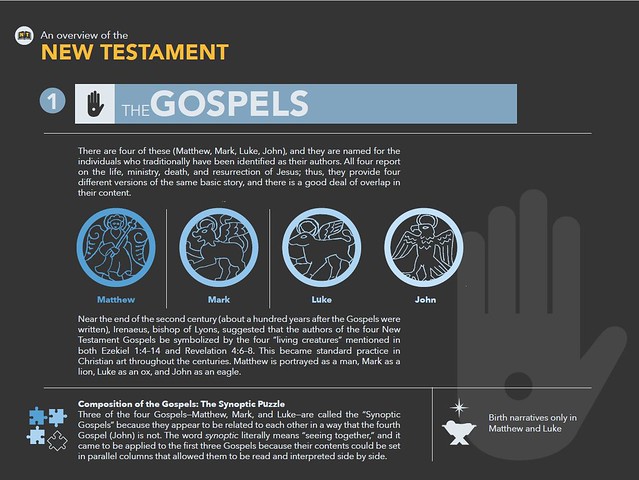Introducing the New Testament, 2nd Edition
A Historical, Literary, and Theological Survey
5. The Gospels
Video Introduction
Summary
The New Testament contains four Gospels that are not exactly like any other books known to us. In terms of genre, they are probably most similar to ancient biographies, but they contain various types of literature within their pages and also evince the influence of Jewish narratives found in the Old Testament. Furthermore, they differ from modern biographies in notable ways: they employ a fictive (“fictionlike”) style of narrative and they are overtly evangelistic.
The Gospels contain more than forty parables, which are stories or sayings of Jesus that have an illustrative or symbolic meaning to them. They also contain numerous accounts of Jesus working miracles—acts of extraordinary power that astonish onlookers. They contain “pronouncement stories,” which function as vehicles for preserving sayings of Jesus within memorable contexts, and they sometimes also report isolated sayings of Jesus that scholars seek to classify according to content or type. Finally, all four Gospels conclude with extended narratives of Jesus’s crucifixion and resurrection.
Much scholarly attention has focused on “the Synoptic Puzzle,” the question of how the first three Gospels (Matthew, Mark, and Luke) might be related to each other. The dominant theory suggests that the Gospel of Mark and another, now lost, work called the Q source were written first; Matthew used both Mark and Q as sources when composing his Gospel, in addition to some other material (called “M”); likewise, Luke used both Mark and Q when composing his Gospel, in addition to some other material (called “L”). Alternative theories dispense with Q altogether: one suggestion contends that Matthew wrote his Gospel first, that Luke used Matthew’s Gospel as a source, and that Mark produced his work last as a condensation of the other two; another holds that Mark’s Gospel came first, Matthew modified Mark, and Luke drew upon both Mark and Matthew.
Study Questions
Describe how each of the four Gospels presents a distinctive portrait of Jesus. For each Gospel, describe the image of Jesus that is presented more prominently and clearly in that one book than in any of the other three.
How did ancient biographies differ from modern ones? List five features of the Gospels that would have been typical for biographies at the time but would not be typical of biographies today.
Indicate at least three different ways that parables function within the Gospels.
How might a typical response to miracle stories in our modern world differ from a typical response to such stories in the world that produced the Gospels?
What is a “pronouncement story” and how do such stories function in the New Testament Gospels?
How does the story of Jesus’s passion and resurrection serve as a distinctive theological climax for each of the four Gospels in which it is related?
Diagram two solutions to “the Synoptic Puzzle” and indicate why this discussion is important for Gospel studies.
What is the Q source, and what do scholars think it reveals about the interests or priorities of early Christianity?
Explore Readings
These readings provide a chance for you to explore the New Testament in more depth. The boxes from the text are included here, as well as bibliographies and outlines for the books of the New Testament.
All the Explore readings can also be downloaded as PDFs here.
5.9. Pronouncement Stories in the Gospels: Some Examples (Box 5.6)
5.21. The Inexhaustible Meaning of Parables (Comment from Origen)
5.29. Contents of Q: Material in Matthew and Luke but Not in Mark (Box 5.11)
5.33. Expanding Mark: How Matthew and Luke Arranged Their Gospels
5.36. Healing Stories in the Gospels (Comments from Church Tradition)
5.37. Gospel Miracles in a Fourth-Century Song: Hymn 9 by Prudentius
Video: Later Images of Jesus
Interactive: Suggested Solutions to the Synoptic Puzzle
Click to see how scholars think the Synoptic Gospel writers may have used sources in their Gospel composition.
Interactive: The Dying Words of Jesus
Click to compare the dying words of Jesus in Matthew and Mark, Luke, and John.
Assets
-
4.4. Parables in the Gospels (Box 5.3)Download
-
4.6. Four Pictures of Jesus (Box 5.1)Download
-
5.0. Bibliography: The Gospels (General)Download
-
5.1. Bibliography: Infancy NarrativesDownload
-
5.2. Bibliography: ParablesDownload
-
5.3. Bibliography: Miracle StoriesDownload
-
5.4. Bibliography: Passion NarrativesDownload
-
5.5. Bibliography: Resurrection NarrativesDownload
-
5.6. Bibliography: Individual Gospel CharactersDownload
-
5.7. Four Pictures of Jesus (Box 5.1)Download
-
5.8. Sayings of Jesus: Some Examples (Box 5.7)Download
-
5.9. Pronouncement Stories in the Gospels: Some Examples (Box 5.6)Download
-
5.10. Parables in the Gospels (Box 5.3)Download
-
5.11. Miracle Stories in the Gospels (Box 5.5)Download
-
5.12. The Dying Words of Jesus (Box 5.8)Download
-
5.13. What Happens When Jesus Dies?Download
-
5.14. People in the GospelsDownload
-
5.15. Characteristics of Ancient Biographies (Box 5.2)Download
-
5.16. Plutarch on the Purpose of Writing a BiographyDownload
-
5.17. The Gospels and Apostolic Authorship (Box 5.9)Download
-
5.18. A Jewish Perspective on Parables (Box 5.4)Download
-
5.19. A Nonbiblical Exorcism StoryDownload
-
5.20. Parables as AllegoriesDownload
-
5.21. The Inexhaustible Meaning of Parables (Comment from Origen)Download
-
5.22. The Gospel: Four StagesDownload
-
5.23. Literary Characteristics of ParablesDownload
-
5.24. Genre of a Healing StoryDownload
-
5.25. Miracles and the Modern MindDownload
-
5.26. Suggested Solutions to the Synoptic Puzzle (Box 5.1)Download
-
5.27. Evidence to Support the Two-Source HypothesisDownload
-
5.28. The Q Source in Contemporary ScholarshipDownload
-
5.29. Contents of Q: Material in Matthew and Luke but Not in Mark (Box 5.11)Download
-
5.30. Material Unique to Matthew's Gospel (Box 6.1)Download
-
5.31. Material Unique to Luke's Gospel (Box 8.1)Download
-
5.32. Material Unique to Mark's Gospel (Box 7.4)Download
-
5.33. Expanding Mark: How Matthew and Luke Arranged Their GospelsDownload
-
5.34. Evidence to Support the Farrer TheoryDownload
-
5.35. Evidence to Support the Two-Gospel HypothesisDownload
-
5.36. Healing Stories in the Gospels (Comments from Church Tradition)Download
-
5.37. Gospel Miracles in a Fourth-Century Song Hymn 9 by PrudentiusDownload

